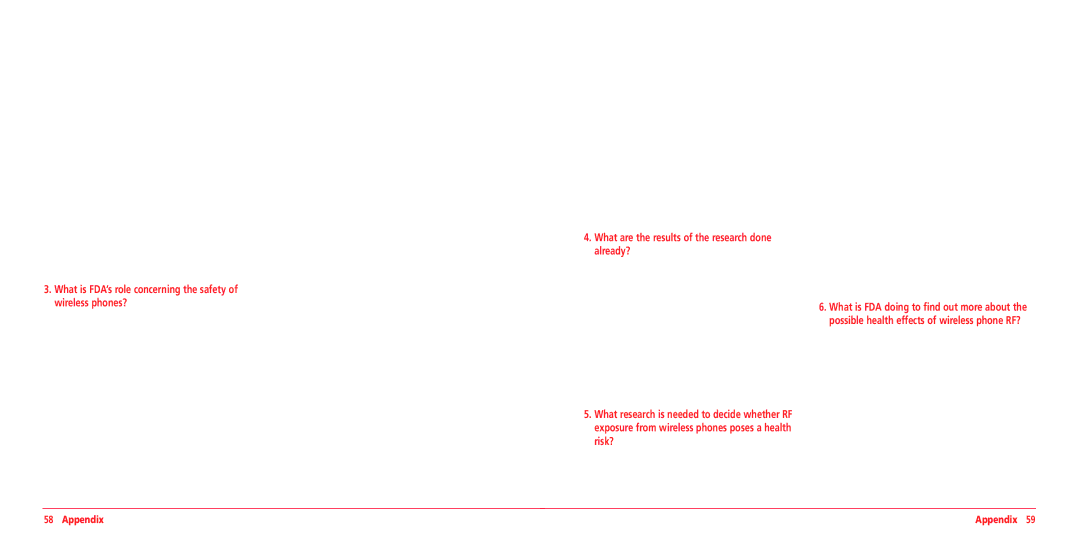that any health problems are associated with using wireless phones. There is no proof, however, that wireless phones are absolutely safe. Wireless phones emit low levels of radiofrequency energy (RF) in the microwave range while being used. They also emit very low levels of RF when in the standby mode. Whereas high levels of RF can pro- duce health effects (by heating tissue), exposure to low level RF that does not produce heating effects causes no known adverse health effects. Many studies of low level RF exposures have not found any biological effects. Some studies have suggest- ed that some biological effects may occur, but such findings have not been confirmed by additional research. In some cases, other researchers have had difficulty in reproducing those studies, or in deter- mining the reasons for inconsistent results.
3.What is FDA’s role concerning the safety of wireless phones?
Under the law, FDA does not review the safety of radiation-emitting consumer products such as wire- less phones before they can be sold, as it does with new drugs or medical devices. However, the agen- cy has authority to take action if wireless phones are shown to emit radiofrequency energy (RF) at a level that is hazardous to the user. In such a case, FDA could require the manufacturers of wireless phones to notify users of the health hazard and to repair, replace or recall the phones so that the hazard no longer exists.
Although the existing scientific data do not justify FDA regulatory actions, FDA has urged the wireless
phone industry to take a number of steps, includ- ing the following:
•Support needed research into possible biologi- cal effects of RF of the type emitted by wireless phones;
•Design wireless phones in a way that minimizes any RF exposure to the user that is not neces- sary for device function; and
•Cooperate in providing users of wireless phones with the best possible information on possible effects of wireless phone use on human health FDA belongs to an interagency working group of the federal agencies that have responsibil- ity for different aspects of RF safety to ensure coordinated efforts at the federal level. The fol- lowing agencies belong to this working group:
•National Institute for Occupational Safety and Health
•Environmental Protection Agency
•Federal Communications Commission
•Occupational Safety and Health Administration
•National Telecommunications and Information Administration
The National Institutes of Health participates in some interagency working group activities, as well.
FDA shares regulatory responsibilities for wire- less phones with the Federal Communications Commission (FCC).
All phones that are sold in the United States must
comply with FCC safety guidelines that limit RF
exposure.
FCC relies on FDA and other health agencies for safety questions about wireless phones.
FCC also regulates the base stations that the wire- less phone networks rely upon. While these base stations operate at higher power than do the wireless phones themselves, the RF exposures that people get from these base stations are typically thousands of times lower than those they can get from wireless phones. Base stations are thus not the primary subject of the safety questions dis- cussed in this document.
4.What are the results of the research done already?
The research done thus far has produced conflict- ing results, and many studies have suffered from flaws in their research methods. Animal experi- ments investigating the effects of radiofrequency energy (RF) exposures characteristic of wireless phones have yielded conflicting results that often cannot be repeated in other laboratories. A few animal studies, however, have suggested that low levels of RF could accelerate the development of cancer in laboratory animal.
5.What research is needed to decide whether RF exposure from wireless phones poses a health risk?
A combination of laboratory studies and epide- miological studies of people actually using wireless phones would provide some of the data that are
needed. Lifetime animal exposure studies could be completed in a few years.
However, very large numbers of animals would be needed to provide reliable proof of a cancer promoting effect if one exists. Epidemiological studies can provide data that is directly applicable to human populations, but 10 or more years’ fol- low-up may be needed to provide answers about some health effects, such as cancer. This is because the interval between the time of exposure to a cancer-causing agent and the time tumors develop - if they do - may be many, many years. The inter- pretation of epidemiological studies is hampered by difficulties in measuring actual RF exposure during day-to-day use of wireless phones. Many factors affect this measurement, such as the angle at which the phone is held, or which model of phone is used.
6.What is FDA doing to find out more about the possible health effects of wireless phone RF?
FDA is working with the U.S. National Toxicology Program and with groups of investigators around the world to ensure that high priority animal stud- ies are conducted to address important questions about the effects of exposure to radiofrequency energy (RF).
FDA has been a leading participant in the World Health Organization International Electromagnetic Fields (EMF) Project since its inception in 1996. An influential result of this work has been the devel- opment of a detailed agenda of research needs that has driven the establishment of new research
